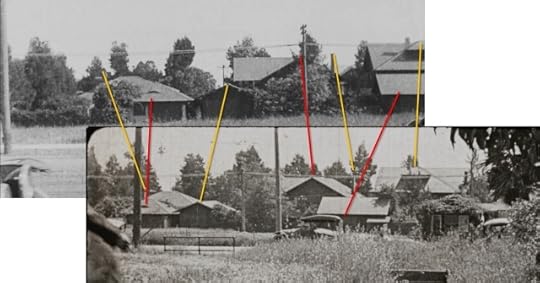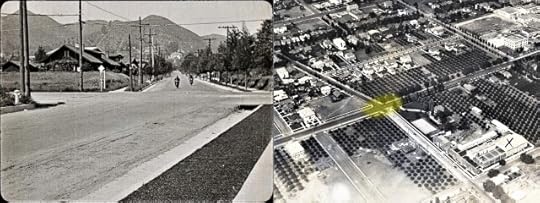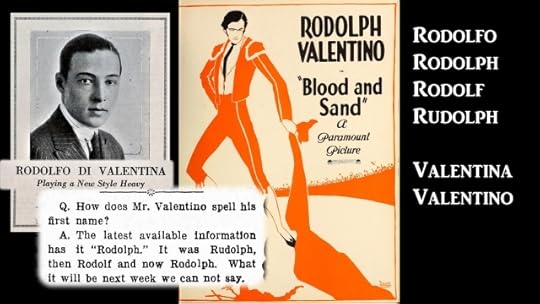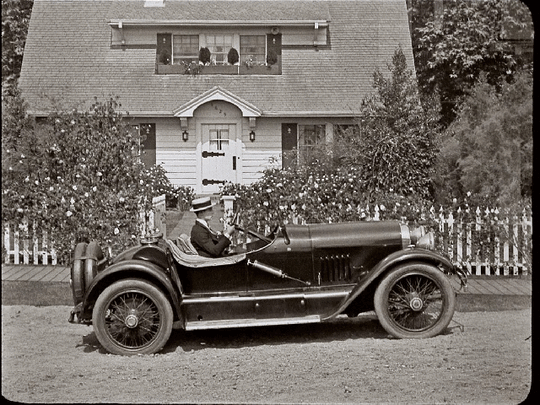John Bengtson's Blog, page 5
August 6, 2022
Billy Bevan’s “Lizzies of the Field” before Griffith Observatory
 This post is dedicated with heartfelt appreciation to Dave Glass and Dave Wyatt, who join the growing ranks of silent film superheroes preserving and restoring classic films, and making them available on home video to grateful fans. Having released compilations of Lloyd Hamilton shorts in 2017, and Lupino Lane comedies on Kickstarter in 2020, their latest 2022 Kickstarter release is a striking two-disc Blu-ray release of nearly 20 comedies starring Billy Bevan, well over 5 hours of fun. One film that immediately caught my attention is the 1924 Keystone release Lizzies of the Field, featuring a spectacular auto race from which brief clips have appeared in vintage compilations previously hosted by Robert Youngson and Paul Killiam. The two reel film, discovered in the Eye Filmmuseum archive, scanned by Lobster Films, and restored by Lobster and Dave Glass, is presented here complete in stunning detail for the first time.
This post is dedicated with heartfelt appreciation to Dave Glass and Dave Wyatt, who join the growing ranks of silent film superheroes preserving and restoring classic films, and making them available on home video to grateful fans. Having released compilations of Lloyd Hamilton shorts in 2017, and Lupino Lane comedies on Kickstarter in 2020, their latest 2022 Kickstarter release is a striking two-disc Blu-ray release of nearly 20 comedies starring Billy Bevan, well over 5 hours of fun. One film that immediately caught my attention is the 1924 Keystone release Lizzies of the Field, featuring a spectacular auto race from which brief clips have appeared in vintage compilations previously hosted by Robert Youngson and Paul Killiam. The two reel film, discovered in the Eye Filmmuseum archive, scanned by Lobster Films, and restored by Lobster and Dave Glass, is presented here complete in stunning detail for the first time.
I’ve always been fascinated by Lizzies as it contains a rare traveling shot heading toward the north portal of the Hill Street Tunnel running beneath Court Hill. The first bore to the right was built in 1908 for the trolleys from Hollywood, before anyone owned cars. The wide bore to the left, for two-way auto traffic, was built in 1913. The landmark tunnel and the hill were obliterated decades ago – read more HERE. Photo LAPL.
Lizzies is especially remembered for its wild auto race snaking along the twisted roads carved into the once barren hills looking down on Hollywood. A century later, with massive development and home landscaping blocking the views, would any clues be discernible? Above, click to enlarge – looking south from the stairway beside 2763 Glendower Ave.
Click to enlarge. The open expanse below – looking south from the stairway, reveals a massive home still standing at 4848 Los Feliz Ave.
Above, zooming past 2814 Glendower Ave. followed by mild bends in the road and then a sharp hairpin turn.
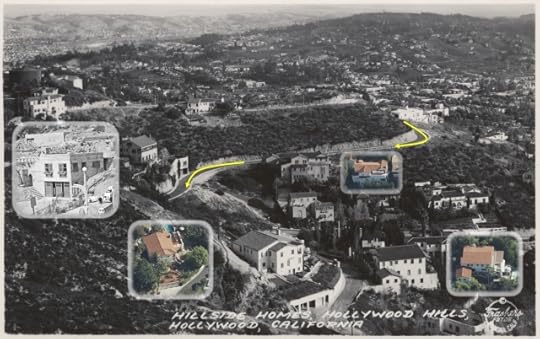
Click to enlarge – view SE at 2814 Glendower Ave (movie frame left). California State Library.
Above, a vintage aerial view of Glendower Ave – with matching modern insets confirming the site. The movie frame at left is looking to the NW while the main photo looks SE.
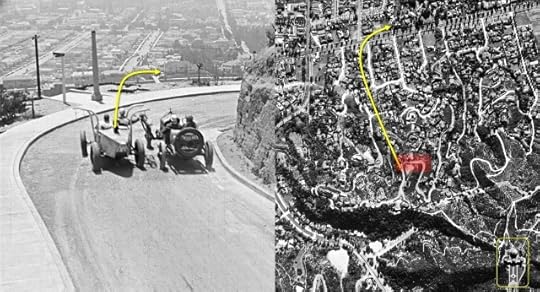
Click to enlarge – view south from Glendower stairway to 4848 Los Feliz – the Griffith Observatory lower left.
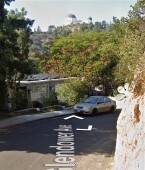 Both views above look south. Marked in red, Glendower makes a sharp right turn west, then another sharp right turn north, followed by a mild bend beside 2814 Glendower, leading to a hairpin turn prominent in the film. When making that second right turn today, the Griffith Observatory, completed in 1935, now looms overhead in the background (left). FrameFinder c-113_228.
Both views above look south. Marked in red, Glendower makes a sharp right turn west, then another sharp right turn north, followed by a mild bend beside 2814 Glendower, leading to a hairpin turn prominent in the film. When making that second right turn today, the Griffith Observatory, completed in 1935, now looms overhead in the background (left). FrameFinder c-113_228.
Click to enlarge – matching SE views before and after the Griffith Observatory was built. The boxes mark the same homes, the arrows mark the second right hand turn north on Glendower. The first right hand turn beside the top of the stairs is blocked from view. California State Library.


Above, two more views of the spectacular race along Glendower.
For more vintage hilltop views of early Hollywood, above, check out The Roaring Road (1926).
Thanks again to Dave Glass and Dave Wyatt for their heroic work. Here’s the link to the Dave Glass YouTube channel, loaded with dozens of rare silent comedies.
Speaking of YouTube, check out “Case Closed – How Buster Keaton made Sherlock Jr.” accompanied by renowned pianist and composer Michael D. Mortilla.
Below, looking south at the top of the Glendower Stairs. To follow Billy’s path, make the right turn, continue to the next corner, turn right again, and on to where 2814 Glendower still stands tall, then past the bend, continuing to the sharp hairpin turn.
July 16, 2022
What? Buster Keaton’s Studio Appears in Seven Chances!
Buster Keaton filmed dozens of scenes beside or adjacent to his small studio at Lillian Way and Eleanor. In a surprising new discovery, the corner of his studio actually appears during a scene from Seven Chances (1925) as Buster jogs up Vine Street, and stumbles upon the mob of angry jilted brides who were chasing him. Other buildings in the scene remain standing today.

Click to enlarge – view north up Vine. Buster runs from Station No. 6, the left corner building, past the CALIFORNIA LAUNDRY, towards the HOTEL Eleanor at back. University of Southern California Libraries and California Historical Society, digitally reproduced by the USC Digital Library.
The sequence begins with Buster, having distanced himself from the main phalanx of the mob, jogging north past the DWP Distribution Station No. 6 at 1007 Vine, the white, left corner building in the main photo above, and in the Water and Power Associates photo pictured below.
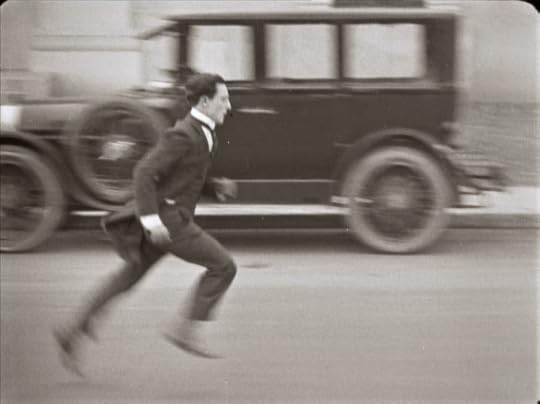



A modern view – Buster’s head aligns with the narrow palm tree.

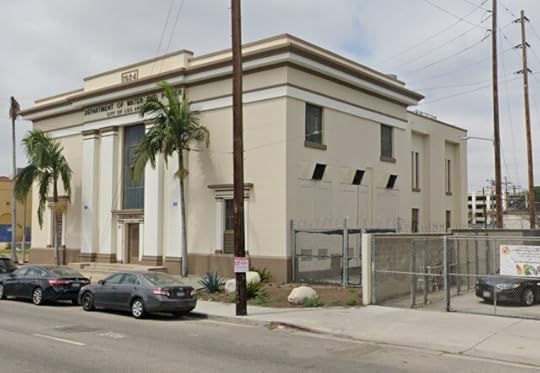
The north corner of Station No. 6 and matching driveways appear above.



Buster continues north up Vine beside the California Laundry (now a parking lot) to the SW corner of Eleanor. The women are also running north up Vine along the front of the laundry.
Click to enlarge – at left appears the great Seven Chances reveal. Looking west from Vine down Eleanor, Buster and some of the women spot each other. The green lawn and yellow fence match the corner of Buster’s studio at right, seen looking south down Lillian Way across Eleanor.

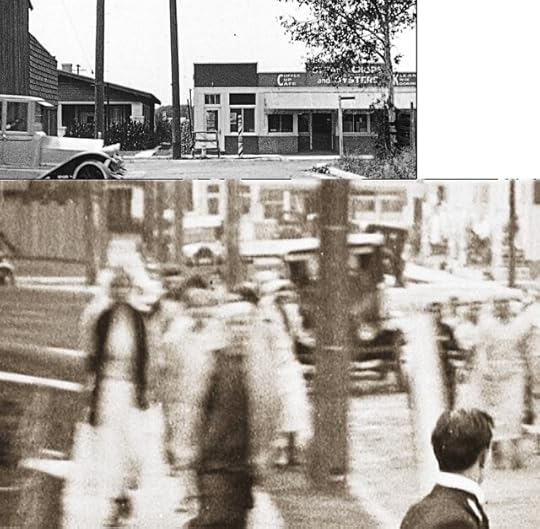
At left this scene from The Blacksmith (1922) looking west down Eleanor shows the back corner of the Keaton Studio barn, along with the bungalow, barber shop, and “Coffee Cup Cafe” across the street along Cahuenga that were later replaced by the Technicolor Building in 1930. They appear aligned directly above their positions in this matching scene from Seven Chances.
Another match, the fence behind Buster’s head is where he staged a scene fleeing from Steve Murphy in Sherlock Jr. (1924), both look west down Eleanor toward Lillian Way.
At left, looking east from the studio down Eleanor towards Vine as Buster stunt doubles for another actor by falling off a motorcycle in Sherlock Jr. The fence to the left and the sidewalk to the right are the same sidewalk and fence appearing in Seven Chances, upper right, looking west down the same block. The right side of the Sherlock frame also shows the north side of the California Laundry – the Vine St. side of the laundry appears to the lower right.



Last, Buster dashes further north past the NW corner of Eleanor and Vine, at the time the Hotel Eleanor – 1057 Vine. Still standing, the hotel building has been “improved” beyond recognition.
The Niles Essanay Silent Film Museum is screening Seven Chances on Saturday July 30 at 7:30 pm, with the wonderful musician, scientist, and film archivist/historian Jon Mirsalis providing live musical accompaniment. I made this discovery preparing for the illustrated talk I will present then when introducing the film. The Seven Chances screening is but one part of a full weekend of tours, events, and other film screenings to be hosted at Niles. You can find all the details HERE.
A dozen posts across this blog reveal other new discoveries from Seven Chances, including Buster’s girlfriend’s house above, and scenes where Buster filmed adjacent to his studio. Look for them all HERE and HERE.
Checkout the many video tours on my YouTube Channel, including this tour which shows the Keaton Studio and its environs.
To download a fully annotated PDF walking tour of the Keaton Studio (not yet updated with these Vine St. locales) click HERE.
Looking west down Eleanor from Vine, where the Buster noticed the mob and dashed to the right. Pan to the left to see the Distribution Station No. 6 down the street.
July 2, 2022
Case Closed! How Buster Keaton filmed Sherlock Jr.
Hosted by the Catalina Museum for Art and History, earlier this year I had the thrill and honor to introduce their screening of Buster Keaton’s brilliant comedy Sherlock Jr. (1924), accompanied by renowned pianist and composer Michael D. Mortilla. With Michael’s invaluable assistance we have transposed this presentation into a beautifully accompanied, narration-free video.
As shown, Buster not only filmed Sherlock Jr. conveniently beside his small studio, but also all across Southern California, from Chatsworth to Placentia and Newport Beach.
Above, Buster seeks to escape the villains disguised as a beggar-woman, directly across the street from his studio barn, appearing in The Blacksmith (1922). At back in both scenes appears the Coffee Cup Cafe, home of Klean Kwik Kooking, serving STEAKS CHOPS and OYSTERS. Read more HERE.
Now filming in Hollywood, Buster opens his bank vault front door and steps onto Hollywood Blvd. at La Brea. He built his small set on a triangular traffic island that is now called the Hollywood Gateway. Read more HERE.
While I cover Sherlock Jr. extensively in my book Silent Echoes, and report many newer discoveries elsewhere across this blog (click HERE), the video contains even more new discoveries. For example, during Buster’s interplay with his motorcycle-riding assistant Gillette, the sequence cuts back and forth between shots filmed on Larchmont Ave., north of Beverly Drive, and on Lucerne Ave., south of Beverly, several blocks away.
The video even shows how Buster filmed a mundane scene near the Arden Grocery once standing at Motor Avenue and National Ave. in Palms, where he and Roscoe Arbuckle made The Hayseed (1919) years earlier, and where Stan Laurel filmed Kill or Cure (1923).
Be sure to check out my YouTube channel. I now have eight (!) videos posted, and hope to continue posting new videos every month or so.
In closing, I again want to express my sincere gratitude and thanks to the Catalina Museum for Art and History for inviting me to speak, and to Michael D. Mortilla for his brilliant music and friendship. I encourage you to support them both. I also encourage you to visit Catalina Island, a magical place that once played host to all the great silent film stars. Above, my first visit in 30 years, a lovely lonely view on Pebbly Beach Road looking north to the Avalon Catalina Casino at left. This was taken later in the evening after the Museum, Michael and others musicians, including Jay Mason, presented Rudolph Valentino’s Blood and Sand (1922) at the Avalon Casino Theatre, as part of the Avalon Silent Film Showcase, one of the world’s longest running annual celebrations of Silent Film.
June 18, 2022
Soft Shoes – Crossing Paths with Chaplin, Laurel, and Lloyd
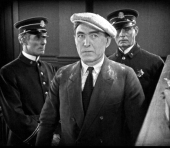 Now streaming on the San Francisco Silent Film Festival’s website, Harry Carey’s 1925 action/drama Soft Shoes, in which Carey (right) seeks to rescue a young woman from a life of crime, was purportedly set in San Francisco. Yet
Now streaming on the San Francisco Silent Film Festival’s website, Harry Carey’s 1925 action/drama Soft Shoes, in which Carey (right) seeks to rescue a young woman from a life of crime, was purportedly set in San Francisco. Yet 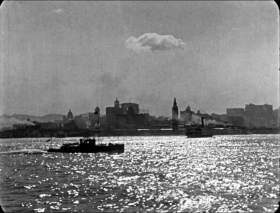 the film’s many captivating exteriors, including the rarely seen streets of Ocean Park, were all filmed, unsurprisingly, in Los Angeles instead. But as shown below, the movie intersects remarkably with classic films made by Charlie Chaplin, Harold Lloyd, and Stan Laurel, while documenting historic LA settings, including its long lost Chinatown. This brief shot at left, looking west towards the Ferry Building, is the lone scene filmed in San Francisco. This movie was so much fun to watch (and investigate), and now everyone can watch it streaming HERE.
the film’s many captivating exteriors, including the rarely seen streets of Ocean Park, were all filmed, unsurprisingly, in Los Angeles instead. But as shown below, the movie intersects remarkably with classic films made by Charlie Chaplin, Harold Lloyd, and Stan Laurel, while documenting historic LA settings, including its long lost Chinatown. This brief shot at left, looking west towards the Ferry Building, is the lone scene filmed in San Francisco. This movie was so much fun to watch (and investigate), and now everyone can watch it streaming HERE.
As reported in a prior post, the Festival’s world premiere screening of its Soft Shoes restoration was presented at the Castro Theatre on May 31, 2018, along with the 1924 Stan Laurel short comedy Detained, recently restored by Lobster Films in collaboration with the Fries Film Archief (Holland), below, where Stan’s prison release matches where Charlie Chaplin was released from prison in Police (1915), both beside the former north gate to the Los Angeles County Hospital – LAPL. Read more about them filming at the north hospital gate, and about Laurel & Hardy filming The Second Hundred Years (1927) and The Hoose-Gow (1929) at the west hospital gate HERE.
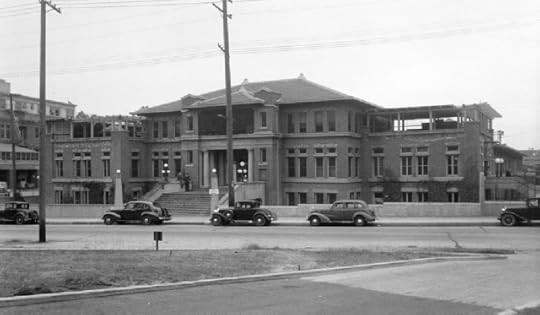

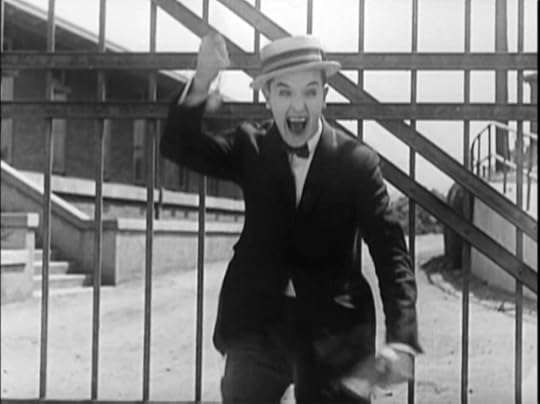
To begin, Soft Shoes depicts Harry Carey sneaking in and out of apartment buildings – the first to appear is the Bryson (lower left), still standing at 2701 Wilshire Boulevard near Lafayette Park.
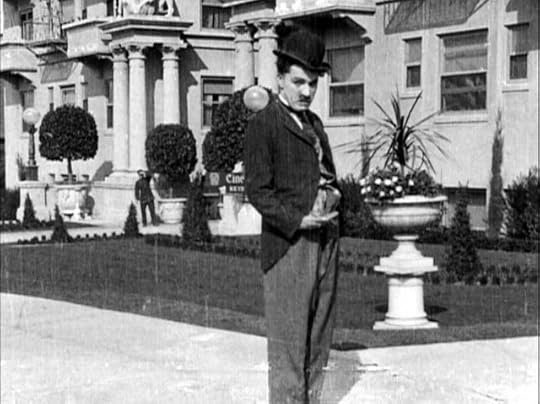
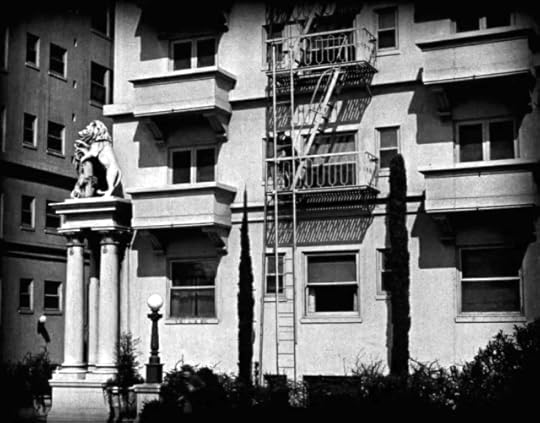

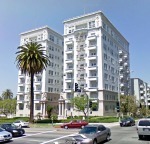 The Bryson portrayed the front of the Mack Sennett Keystone Studios, upper left above, during one of Charlie Chaplin’s earliest movies, A Film Johnnie (completed February 11, 1914, barely his second month on the job). In that film Charlie’s “Little Tramp” pesters Keystone actors as they enter and depart the “studio.” While the true Keystone studio façade actually appears in dozens of other Sennett productions, for some reason the far more impressive Bryson was employed in the Chaplin film. (Upper right –LAPL). The Bryson’s prominent front fire escape appears several times during Soft Shoes, lower left above, along with the distinctive stone lions that still guard the apartment entranceway.
The Bryson portrayed the front of the Mack Sennett Keystone Studios, upper left above, during one of Charlie Chaplin’s earliest movies, A Film Johnnie (completed February 11, 1914, barely his second month on the job). In that film Charlie’s “Little Tramp” pesters Keystone actors as they enter and depart the “studio.” While the true Keystone studio façade actually appears in dozens of other Sennett productions, for some reason the far more impressive Bryson was employed in the Chaplin film. (Upper right –LAPL). The Bryson’s prominent front fire escape appears several times during Soft Shoes, lower left above, along with the distinctive stone lions that still guard the apartment entranceway.


Built in 1913, the Bryson also appears prominently above Chaplin’s head during a scene from his Mutual comedy The Rink (1916), where Charlie meets Edna Purviance on the street at the SE corner of Wilshire Place and Ingraham (now Sunset Place). The Bryson may be best known as a setting described in Raymond Chandler’s 1943 Philip Marlowe detective classic The Lady in the Lake. Color photo Jeffrey Castel De Oro.
Soft Shoes also features the police chasing Harry around another high rise, including the roof, filmed at the Franconia Apartments still standing at 6th and Coronado north of MacArthur Park, pictured above facing 6th Street. The Asbury Apartments mentioned below appears to the far right. USC Digital Library.

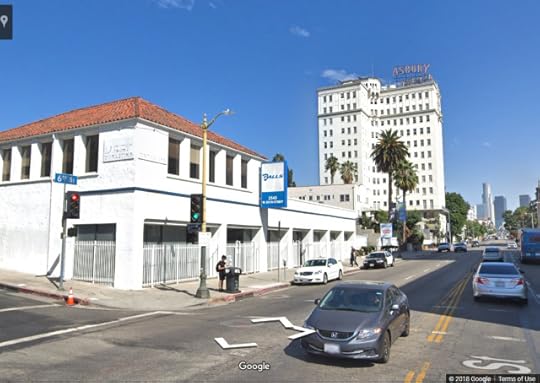
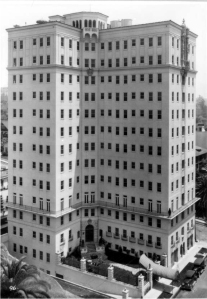 This scene of a cop racing towards what turned out to be the Franconia contains two vital clues. At the time J. W. Calder had two corner drug stores, but only his store at 2549 W 6th Street aligned with a tall building at back. As such, this
This scene of a cop racing towards what turned out to be the Franconia contains two vital clues. At the time J. W. Calder had two corner drug stores, but only his store at 2549 W 6th Street aligned with a tall building at back. As such, this 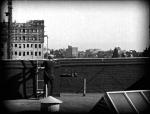 shot above reveals the Asbury Apartments undergoing construction, which opened later in 1925, still standing at 2505 W. 6th Street. (Asbury left – USC Digital Library). By correctly assuming the rooftop scenes (click to enlarge – inset right) also depict the same Asbury Apartments under construction, triangulating back from the Asbury identified the Franconia as the primary shooting site.
shot above reveals the Asbury Apartments undergoing construction, which opened later in 1925, still standing at 2505 W. 6th Street. (Asbury left – USC Digital Library). By correctly assuming the rooftop scenes (click to enlarge – inset right) also depict the same Asbury Apartments under construction, triangulating back from the Asbury identified the Franconia as the primary shooting site.


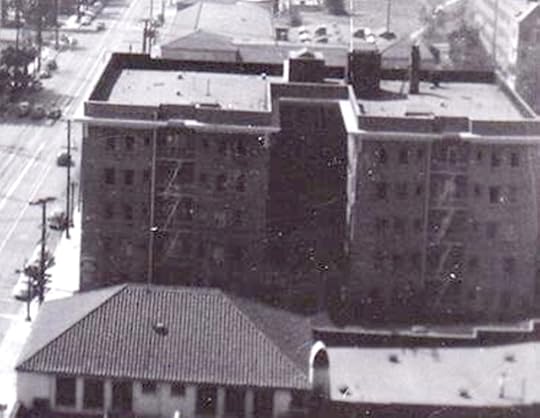
The Franconia has a recessed fire escape shaft on each wing facing Coronado Street, put to good use as the cops follow Harry to the roof during Soft Shoes. The color image is the north wing shaft, the movie frame could depict either wing. Vintage photo Don Lynch.


Here Carey peeks north up Coronado, with buildings at back still standing. The Franconia’s decorative rooftop ledges were removed for earthquake safety reasons. Carey crouches on the south ledge of the north wing, while the camera peers across towards him from the south wing.


The view above looking NW from the Franconia roof (left) reveals a stretch of Rampart Boulevard, beginning with the Villa d’Este Apartments at 401 Rampart (A), to the corner of Rampart and W. 3rd Street (D), all appearing in Harold Lloyd’s For Heaven’s Sake (1926) (right, Harold with straw hat). As I explain in my Lloyd book Silent Visions, Harold filmed the drunken groomsmen bus scene, shown here, extensively on Rampart between 6th and 3rd, where nearly every building on the street appears onscreen and remains standing today. The Rampart corner (D) also appears in Lloyd’s Girl Shy (1924).

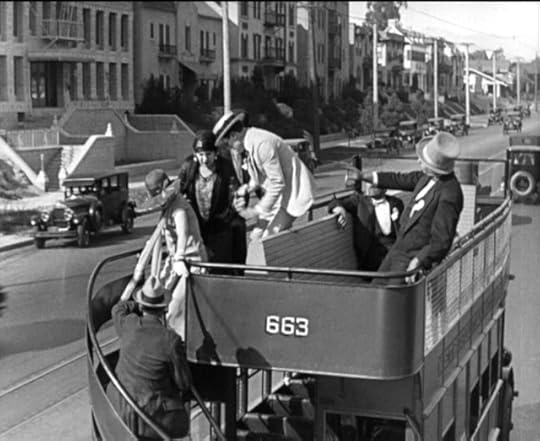
Below, further action takes place in Ocean Park, the small beach community south of Santa Monica.


Above left, a 1924 view east of Ocean Park, showing Ocean Front, Pier Avenue, and Marine Avenue (Huntington Digital Library). The photo documents the aftermath of the January 6, 1924 fire that destroyed the Pickering and Lick Piers. To the right, a circa 1915 view east down Pier Avenue and Marine Avenue (Huntington Digital Library). Note the church on Marine at back. The front vacant lot is where a billiard parlor (below) would be built.

Click to enlarge. The “Billiards” building far right in the movie frame is newer, built after the photo was taken. The far right photo building says “BRADLEY” at the roof ledge, matching the Hotel Bradley in the movie frame. The J.N. Mooser Dry Goods building appears as Ocean Park Dry Goods in the movie frame. Note the matching sidewalk clock in both images.
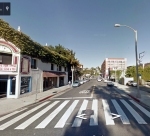 This scene above (cropped) of Carey fleeing by automobile was filmed looking east on Pier Avenue towards Main from what was once called Ocean Front (now Neilson Way), the grand promenade that originally fronted the beach. The “FARROW’S RESTAURANT” appearing at back once stood at 130 Pier Avenue, on the ground floor of the Hotel Bradley at 130 1/2 Pier Avenue. Further back stands the Olga Hotel at 142 1/2 Pier Avenue. None of the buildings captured in this scene remain in the modern view (left).
This scene above (cropped) of Carey fleeing by automobile was filmed looking east on Pier Avenue towards Main from what was once called Ocean Front (now Neilson Way), the grand promenade that originally fronted the beach. The “FARROW’S RESTAURANT” appearing at back once stood at 130 Pier Avenue, on the ground floor of the Hotel Bradley at 130 1/2 Pier Avenue. Further back stands the Olga Hotel at 142 1/2 Pier Avenue. None of the buildings captured in this scene remain in the modern view (left).

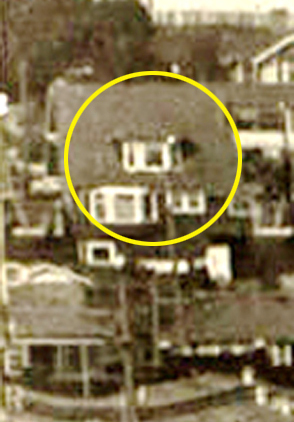
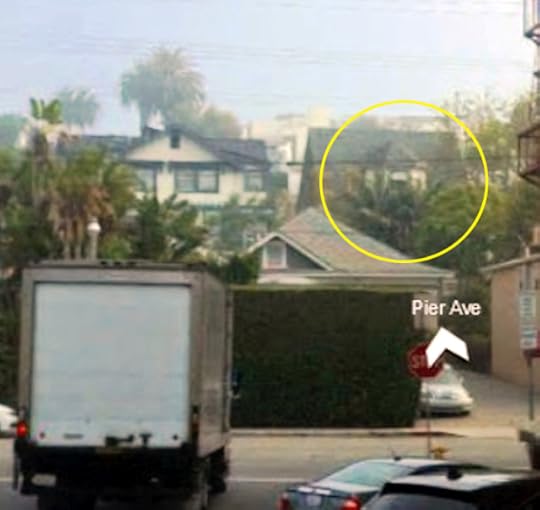
While none of the Pier Avenue commercial buildings appearing in the movie remain today, the rear of the uphill homes still standing at 3014 and 3018 3rd Street remain visible in the far background – compare above the movie, historic photo, and modern views. (Color image (C) 2018 Microsoft Corporation).


This view looks east down Marine Street, parallel to and a block south from Pier Avenue, towards the former St. Clement’s Church that once stood on the SE corner of Washington Boulevard (now 2nd Street) and Marine. The large building at the center of the movie frame is the side of the former Masonic Temple at 162 Marine.
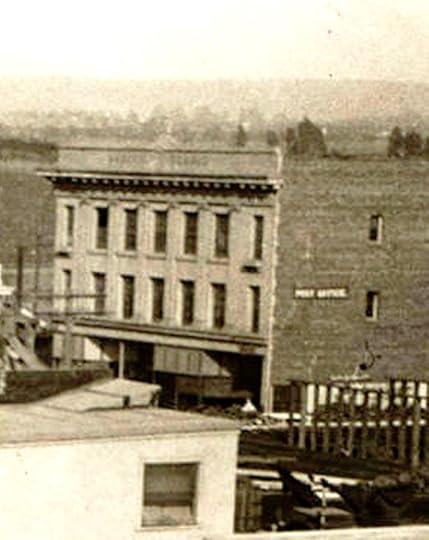

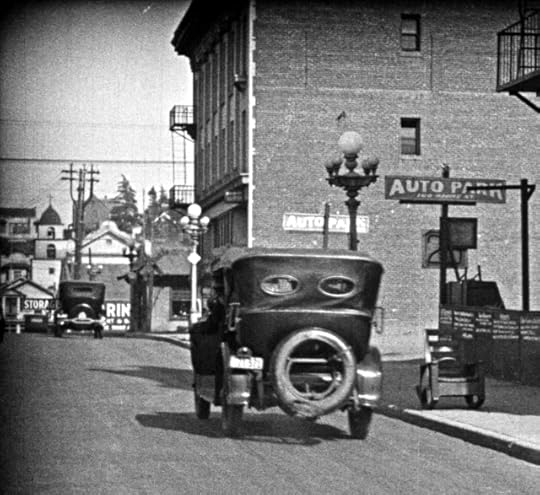

A closer view of the west side of the former Masonic Temple (center), and at back, the former St. Clement’s Church (LAPL), both long demolished.


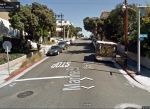 Moments later, Carey switches between cars as they pass on a steep hill, filmed just a block further east along Marine between 3rd and 4th. The retaining walls on the south side of Marine appearing in the film remain in place today. This aerial view clearly shows the Masonic Temple (box), the church (oval), and the hilly street with the retaining walls to the right (line) depicted in the film.
Moments later, Carey switches between cars as they pass on a steep hill, filmed just a block further east along Marine between 3rd and 4th. The retaining walls on the south side of Marine appearing in the film remain in place today. This aerial view clearly shows the Masonic Temple (box), the church (oval), and the hilly street with the retaining walls to the right (line) depicted in the film.
Late in the film, Carey and others run along dingy Chinatown alleys and street corners. Built in the 1880s, the original Chinatown grew east of the Plaza de Los Angeles on former grazing land owned by Mexican land baron Juan Apablasa and his son Cayetano. Denied property ownership, and restricted from living elsewhere, the Chinese suffered the neglect of their landlords, who left the privately owned streets of Chinatown unpaved. Crammed among noisy railroad tracks, towering gaswork plants, and the frequently overflowing Los Angeles River, Chinatown was the city’s least desirable address.
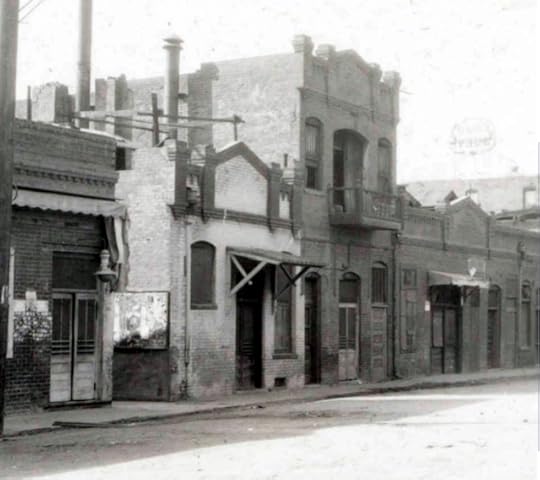
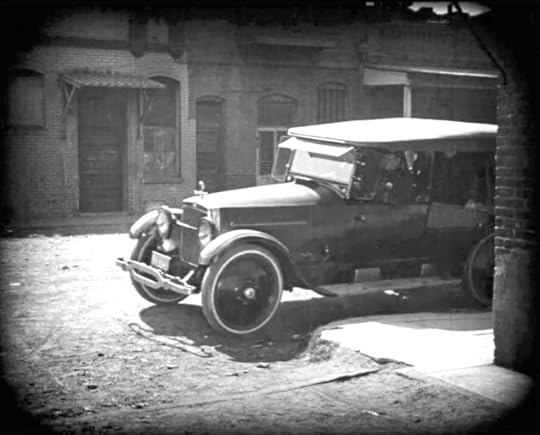

(Above, Huntington Digital Library, left, Soft Shoes upper right, Chaplin’s The Kid, lower right). Once the original leases expired, most of Chinatown was sold in 1914 to make way for the future Union Train Station. After years of litigation, the Chinese were evicted in 1934 for construction of the new terminal that opened to great acclaim in 1937. That same year community leaders formulated a master plan to develop a new Chinatown between Hill and Broadway, a mile northwest from its former site, where it remains today. Three identifiable scenes from Soft Shoes were filmed at the same spot, the corner of a narrow alley running from Marchesault Street to Apablasa Street, across from the corner of Cayetano Alley. Remarkably, one shot matches exactly where Charlie Chaplin filmed a critical scene from The Kid (1921). Here above (upper right Soft Shoes, lower right The Kid) are identical views looking south from Cayetano, across Apablasa, towards the narrow alley corner.


Above, Soft Shoes left, looking SW, a composite image from Chaplin’s The Kid, right, looking south. Both views show the same drainspout and corner alley bulletin board.



Upper left (yellow), Harry Carey runs south from Apablasa Street towards Marchesault Street, down a narrow connecting alley – this may be the only surviving image taken within this alley. Lower left (red), Chaplin at the corner of Cayetano and Apablasa. The purple arrow points west down Apablasa, matching Stan Laurel’s view, below. UC Santa Barbara c-2744_3.


A wide view looking west down Apablasa, with The Kid/Soft Shoes alley corner at the left. Stan Laurel appears at right in Mandarin Mixup (1924). Chaplin filmed Caught In A Cabaret (1914) beside the central building at back. You can read more about Chaplin and Laurel filming in Chinatown on Apablasa (below) in this post HERE.





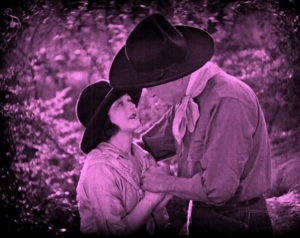 At left, is this a happy ending for Harry Carey? Watch the movie streaming HERE and find out. The 2018 Soft Shoes restoration was completed by the San Francisco Silent Film Festival in partnership with the Czech Republic’s Národní filmový archiv, under the supervision of SFSFF President Rob Byrne, with SFSFF recreating English titles from the original surviving Czech print. Funding for the restoration was generously provided by the National Film Preservation Foundation with additional funding from the San Francisco Silent Film Festival Film Preservation Fund.
At left, is this a happy ending for Harry Carey? Watch the movie streaming HERE and find out. The 2018 Soft Shoes restoration was completed by the San Francisco Silent Film Festival in partnership with the Czech Republic’s Národní filmový archiv, under the supervision of SFSFF President Rob Byrne, with SFSFF recreating English titles from the original surviving Czech print. Funding for the restoration was generously provided by the National Film Preservation Foundation with additional funding from the San Francisco Silent Film Festival Film Preservation Fund.
You can read Hugh Munro Neely’s program essay about Soft Shoes HERE.
You can view my own online presentation for the Festival here – it covers the hidden interplay between silent movies filmed in Hollywood and in San Francisco, along with new discoveries from D.W. Griffith’s Intolerance (1916).
All images from Chaplin films made from 1918 onwards, copyright © Roy Export Company Establishment. CHARLES CHAPLIN, CHAPLIN, and the LITTLE TRAMP, photographs from and the names of Mr. Chaplin’s films are trademarks and/or service marks of Bubbles Incorporated SA and/or Roy Export Company Establishment. Used with permission. HAROLD LLOYD images and the names of Mr. Lloyd’s films are all trademarks and/or service marks of Harold Lloyd Entertainment Inc. Images and movie frame images reproduced courtesy of The Harold Lloyd Trust and Harold Lloyd Entertainment Inc. The Kid – Criterion Collection; Chaplin’s Mutual Comedies; The Stan Laurel Slapstick Symposium Collection Volume 2, Eric Lange and Serge Bromberg, Lobster Films; Chaplin at Keystone Collection, Lobster Films for the Chaplin Keystone Project. Except where noted color images (C) 2018 Google.
Below, the Franconia Apartments.
May 29, 2022
Charlie Chaplin’s One A.M. Mystery
Charlie Chaplin’s 1916 Mutual comedy short One A.M. was unique in many ways. Charlie plays a drunken bon-vivant, returning home after a night on the town. Except for a brief exterior scene with his taxi driver Albert Austin, Charlie plays the entire movie solo inside his home, with no plot beyond his inept attempts to put himself to bed.
Chaplin made the film at his small Lone Star Studio at Lillian Way and Eleanor, that would become Buster Keaton’s home studio four years later. The studio stood a short block south of the Santa Monica Blvd. trolley line. Because a trolley passes Charlie as he struggles exiting the taxi, I had long wondered if Charlie conveniently filmed the scene near his studio.

Click to enlarge – One A.M at left, note trolley tracks, matching homes from Waiting at the Church at right. Look closely, a vacant lot faces the trolley line in the near background. The small structures are garages facing an alley, and the homes further back face an adjacent street, not the trolley line street.
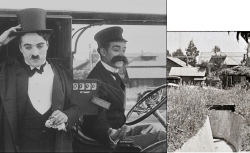 Silent movies not only document the times in which they were made, they also provide clues for solving location mysteries from other films. Enter the comedy duo Lyons and Moran. (At left, the rear of a distinctive matching home from One A.M. and their Waiting at the Church.)
Silent movies not only document the times in which they were made, they also provide clues for solving location mysteries from other films. Enter the comedy duo Lyons and Moran. (At left, the rear of a distinctive matching home from One A.M. and their Waiting at the Church.)
Working with the Library of Congress, silent film hero Michael Aus has made several early Lyons-Moran comedies (his eBay link) available to the public (sale proceeds benefit the Niles Essanay Silent Film Museum). In particular, his release Waiting at the Church (1919) (see post HERE) is one of the most visually consequential silent films I’ve ever seen, with scenes filmed all around early La Brea, Highland, and nascent Hollywood Boulevard. Comparing frames above, Waiting at the Church (bottom frame) clearly provides a broader view of Charlie’s taxi scene from One A.M. (top frame). Look at the matching details; the vacant lot, chimneys, small garages facing an alley, and distinctive roof lines.
But wider views from Waiting at the Church, presumably looking east, show a curved irrigation ditch running below the street with the trolley line, guarded by a metal safety railing (above) to protect people from falling into the ditch. Charlie must have exited his taxi near this railing.

Another matchup – One A.M. at top, Lyons and Moran at bottom, with vacant lots on both sides facing the trolley line.
I’ve studied the 1919 Sanborn fire insurance maps, the 1920 Baist Atlas, and numerous vintage aerial photos. The section of Santa Monica Blvd. near Chaplin’s Mutual Studio lacks a vacant lot with a setback alley and further offset homes. Likewise, tracking north-south along the Western Ave. trolley line doesn’t seem to match the details. My best guess is that Charlie and Lyons-Moran filmed along the north-south Highland Ave. trolley line, looking east, towards the vacant NE corner of Fountain and Highland (homes were never built on this corner, today the site of a strip mall), with an alley separating Highland from the adjacent block McCadden Place. As further “proof,” Lyons and Moran filmed other scenes from Waiting at the Church on this adjacent block of McCadden Place, just steps from the candidate corner.
Public Appeal – while the available clues seem consistent, there’s no definitive proof. The essential puzzle piece, the curved ditch (presumably running parallel along Fountain, then curving north, then east below Highland and the trolley line, then continuing eastward underground) remains elusive. Does anyone know or recognize this early Hollywood clue? Can someone please solve the Chaplin One A.M. mystery?

Click to enlarge – Waiting at the Church. At left, La Brea at Hollywood Blvd., with the Bernheimer Estate up the hill. At right, La Brea looking north towards Santa Monica Blvd., the Bernheimer Estate again at back. The Pickford-Fairbanks Studio on Santa Monica Blvd. stands off camera to the left in the right frame.
During Waiting at the Church Lyons and Moran run up and down La Brea Avenue, a few blocks north or south of Chaplin’s independent studio opened in 1918 at 1416 N. La Brea Ave., providing tantalizing glimpses of Charlie’s neighborhood.
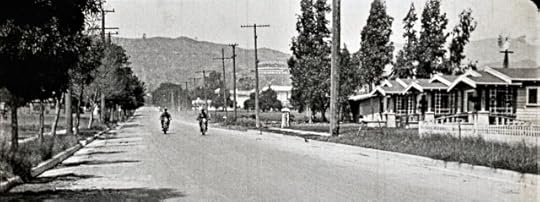
Click to enlarge – Waiting at the Church, looking north up La Brea. The hilltop Bernheimer Estate at center stands directly above a side view of the large, white closed Chaplin Studio shooting stage (see below). Charlie’s corner office entrance stands directly behind the right motorcycle cop.

Side view of Chaplin Studio matching above movie frame from Waiting at the Church.
A final view from Waiting at the Church, looking north from the La Brea – Sunset Blvd. corner of the Chaplin Studio. The mansion on the studio grounds where Charlie’s half-brother Syd once lived stood on the SE corner of this intersection.
Please check my prior post about Waiting at the Church HERE. Above, Lyons and Moran flee the former First Methodist Episcopal Church on the corner of Hollywood and Ivar.
Another Lyons and Moran link with Charlie, they filmed What a Clue Will Do (1917) at 645 New High Street years before Charlie filmed The Kid (1921) at the same spot. Read more HERE.
Charlie’s studio on La Brea was once a lemon orchard. This YouTube video shows more of Charlie’s studio neighborhood.
May 8, 2022
Keaton Sherlock Jr. – Valentino Blood and Sand – at Avalon Silent Film Showcase
Buster Keaton’s brilliant comedy Sherlock Jr., and Rudolph Valentino’s smoldering performance as a conflicted bullfighter in Blood and Sand, highlight this year’s Avalon Silent Film Showcase, hosted on Catalina Island at the beautiful Avalon Casino Theatre, on May 13 – 14. Avalon Sherlock link. Avalon Blood and Sand link. Both screenings will be accompanied with live musical performances by renowned pianist and composer Michael Mortilla.
I will be introducing both films, sharing their visual history. Below, a few snippets from my illustrated talks.
Above, an early scene from Sherlock was filmed beside Buster’s studio corner.
This famous publicity still was taken beside the corner of Keaton’s studio barn.
Rudy spelled his name differently over the years, and was promoted as RODOLPH rather than Rudolph for Blood and Sand.
You can see the bullfighting ring set built for Blood and Sand at the former Lasky Ranch in Burbank, now part of the Forest Lawn Cemetery. (Photo – Valentino author Donna Hill.)
Last, check out my latest video for Buster Keaton’s Steamboat Bill, Jr.
Recognized as one of the world’s longest running annual celebrations of Silent Film, the main event of Avalon’s 35th annual showcase is held in the historic Avalon Casino Theatre, William Wrigley Jr.’s 1929 Art Deco Movie Palace. If you live in the Los Angeles area, I hope you’ll consider supporting the Avalon Silent Film Showcase by attending.
Avalon Sherlock May 13 link. Avalon Blood and Sand May 14 link.
April 16, 2022
The San Francisco Silent Film Festival returns to live cinema – Steamboat Bill, Jr. – Penrod and Sam
The San Francisco Silent Film Festival triumphantly celebrates the return of live cinema hosting its 25th anniversary festival at the Castro Theater May 5-11, 2022. Here is the schedule, which runs a full week – https://silentfilm.org/2022-festival-schedule/
One highlight is the Saturday May 7 screening of Buster Keaton’s remarkably entertaining Steamboat Bill, Jr., accompanied by the wonderful Mont Alto Motion Picture Orchestra. With the aid of vintage aerial photographs, and a score by Mont Alto, I’ve put together this YouTube video showing exactly where Buster left his footsteps along the Sacramento River.
This link takes you to the fantastic National Archives aerial photo featured in the video thumbnail above – https://catalog.archives.gov/id/23935015
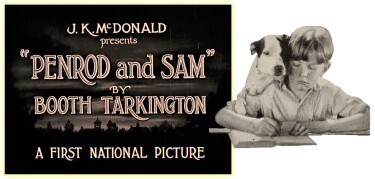 The next day, Sunday May 8, the Festival hosts the nostalgic childhood comedy-drama Penrod and Sam. Based on the Booth Tarkington novel, this popular movie was directed by William Beaudine early in his career. Following a gang of young boys, the movie takes place on an idyllic all-American street, lined with beautiful homes and large yards. But where was it filmed?
The next day, Sunday May 8, the Festival hosts the nostalgic childhood comedy-drama Penrod and Sam. Based on the Booth Tarkington novel, this popular movie was directed by William Beaudine early in his career. Following a gang of young boys, the movie takes place on an idyllic all-American street, lined with beautiful homes and large yards. But where was it filmed?
Above, this unique 1923 photo (click to enlarge), looking east at the then-small USC campus in the foreground, provides the answer. A popular film location site, especially with Buster Keaton (more below) I’ve studied dozens of aerial photos of the campus, which nearly always look north. National Archives – photo mislabeled as Pasadena – https://catalog.archives.gov/id/23935371
Two blocks east from USC, Penrod and Sam was filmed nearly entirely on the 3400 block of S. Flower between W. Jefferson Blvd. and 34th Street. The child Penrod lived at 3421 S. Flower next door to a genuine vacant lot (a critical part of the story). The once beautiful street was later devoured by the Harbor Freeway and the USC Galen Center.

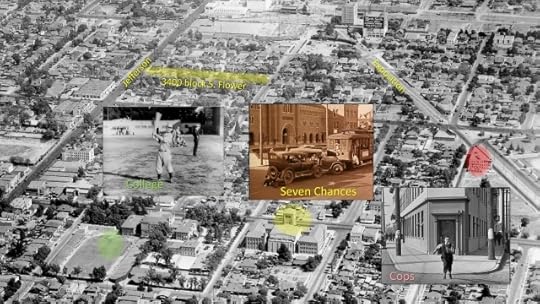 This final image above shows the Penrod street and some of the USC locations where Buster Keaton filmed. This YouTube video below shows even more USC details where Buster filmed, along with scenes with Harold Lloyd and Laurel & Hardy.
This final image above shows the Penrod street and some of the USC locations where Buster Keaton filmed. This YouTube video below shows even more USC details where Buster filmed, along with scenes with Harold Lloyd and Laurel & Hardy.
This link downloads a PDF file with even more Penrod details. For video tours of Charlie Chaplin’s studio, Buster’s studio, and the Chaplin-Keaton-Lloyd Alley, visit my YouTube Channel – https://www.youtube.com/c/SilentLocationsbyJohnBengtson/featured
Visit https://silentfilm.org/ for all the San Francisco Silent Film Festival details.
Below, the once wistfully beautiful site of Penrod’s home.
March 27, 2022
Buster Keaton’s Lost and Found “Seven Chances” Homes
During Seven Chances (1925) Buster’s character discovers on his 27th birthday he must marry by seven o’clock that evening in order to inherit a $7M fortune. After ineptly proposing to his longtime girlfriend, he speeds off to a country club where he fails proposing to seven women acquaintances (his seven chances).
The club was in fact the mansion of larger-than-life Frank P. Flint, a deputy marshal, judge, business tycoon, one-term United States Senator (appointed, not elected), and founder of the town La Canada Flintridge, modestly named after himself. Senator Flint was quite a character, a well-known philanthropist, who delighted being dubbed “The Santa Claus of Los Angeles,” and well-known philanderer, who survived being shot at by one lover’s jealous husband.



Above, Buster poses at the Flint mansion sloping front lawn, and again with co-stars Snitz Edwards and T. Roy Barnes. The central Seven Chances photo reveals only seven fingernails – Buster lost the tip of his right index finger in a childhood accident.


Buster practices his technique proposing to Snitz beside the front entrance. Flint mansion photos California State Library.
Click to enlarge – remodeled or completely rebuilt, the modern home site identifies now as 882 Flintridge Ave., and retains the same two-wing “L” shaped floor plan. Note the matching curved driveway and sloping front lawn. Central 1928 image UC Santa Barbara c-300_k-248.
Above, Buster and Roy chase Snitz from the front corner balustrade down the long, curving driveway. To learn more about the fascinating history of Flint and his eponymous town, check out the Lanterman House Spring 2021 PDF newsletter. Lanterman Historical Museum Foundation.
Now, the NO LONGER lost, now found part, of this lost and found post.
Rejected by his girl, portrayed by Ruth Dwyer, Buster leaves her home and then arrives at the club, presented onscreen with this stunning lap-dissolve transition. While this digital effect is now commonplace, Keaton had the foresight to envision it a century ago, and the skill to create it the old-fashioned way, by re-exposing the same film within the same camera, and using surveying equipment to assure the car was aligned in exactly the same position for both shots.



This post sought reader’s help to identify the home, and Tim Day, and “v.sonia.v,” both quickly solved the puzzle. The home still stands at 1625 Opechee Way in Glendale. Here are the original clues, and my plea for help. Skip further to find the solution. Ruth’s home appears to be genuine, with an authentic-looking “1625” street address. Fully lit by the sun, the home appears to face to the south, and has a sloping hill in the (north?) background.
This panning shot shows the 1625 home situated on a developed street, lined with corners, curbs, sidewalks, lampposts, and landscaping. Aside from the sloped hill at back, and the other clues, presumably this home was relatively near La Canada Flintridge, as Buster and crew had to travel between the home and the “club” to capture the lap-dissolve shots.


Hooray for crowd-sourcing. Here’s a COMPASS listing for the home. While Tim was posting his solution in the comments below, my friend Kim Cooper wrote that “v.sonia.v” had posted the same solution on Kim’s Esotouric Instgram account. Given the time stamps, v.sonia.v could not have read Tim’s account, so we owe them both full credit for their independently rapid solutions. Cheers to all – thank you.
So there you go – Buster’s “1625” home remains a mystery. Can we crowd-source this puzzle? I welcome any clues or suggestions you might want to share.
FYI – crowd-sourcing has worked before. In response to a prior plea for help, an eagle-eyed reader “Skip” (he requested anonymity) solved this long-standing puzzle. Harold Lloyd’s roommate Bill Strother climbed the now heavily remodeled Dresden Apartments at 1919 W. 7th St. during the early scenes of Safety Last! (1923) – see full post HERE.
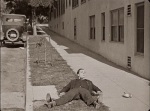 Other posts on this site report “new” Seven Chances locations beyond those covered in my Keaton book Silent Echoes. Someday I will post how Buster dodges a duck hunter at the Playa del Rey marshlands, and how Buster raced along Santa Monica Boulevard directly across the street from the Pickford-Fairbanks Studio. A recent favorite post, Buster was conked on the head by a tossed alarm clock beside the apartment located at 5987 Franklin, at the NE corner of Cheremoya – see full post HERE. My YouTube video Buster Keaton Filming at USC also contains several Seven Chances scenes.
Other posts on this site report “new” Seven Chances locations beyond those covered in my Keaton book Silent Echoes. Someday I will post how Buster dodges a duck hunter at the Playa del Rey marshlands, and how Buster raced along Santa Monica Boulevard directly across the street from the Pickford-Fairbanks Studio. A recent favorite post, Buster was conked on the head by a tossed alarm clock beside the apartment located at 5987 Franklin, at the NE corner of Cheremoya – see full post HERE. My YouTube video Buster Keaton Filming at USC also contains several Seven Chances scenes.
So, with a little luck, perhaps Skip or some other kind reader will solve for us the mystery of Buster’s “1625” Seven Chances home.
It appears Buster and crew had to drive about 4.6 miles between the two sites, a mere 11 minute drive.
March 6, 2022
Buster Keaton’s riverbank footsteps – Steamboat Bill, Jr.
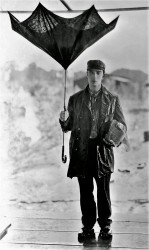 Buster Keaton filmed his final independent production Steamboat Bill, Jr. on location in Sacramento. The movie opens with an elegant scene filmed at the tip of what is now Discovery Park, slowly panning right to left from the American river viewed east, to the Sacramento River viewed north, then west, as a new steamboat puffs downstream towards a pier crowded with a cheering mob, introducing the fictional town of River Junction (see below). Keaton built these extensive sets standing along the west riverbank barely a mile from the State Capitol Building. As explained further below, you can stroll the riverbank today and stand exactly where Buster staged his most famous scenes.
Buster Keaton filmed his final independent production Steamboat Bill, Jr. on location in Sacramento. The movie opens with an elegant scene filmed at the tip of what is now Discovery Park, slowly panning right to left from the American river viewed east, to the Sacramento River viewed north, then west, as a new steamboat puffs downstream towards a pier crowded with a cheering mob, introducing the fictional town of River Junction (see below). Keaton built these extensive sets standing along the west riverbank barely a mile from the State Capitol Building. As explained further below, you can stroll the riverbank today and stand exactly where Buster staged his most famous scenes.

Click to enlarge – composite view west of most of Buster’s riverbank set, depicting two of its three “intersections.” The famous collapsing house was built to the far left, after this publicity photo was taken, suggesting the idea for the stunt came later to Buster – The Sacramento Bee and Sacramento Room, Sacramento Public Library
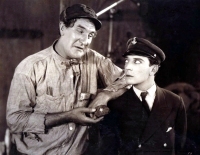 A true Keaton masterpiece, and highly entertaining, Steamboat Bill, Jr. has been inducted into the National Film Registry of the Library of Congress, and is perhaps best remembered for its thrilling cyclone scene where the side of a house falls atop Buster like a giant flyswatter, sparing his life with an open window. Yet with diminutive Buster (5’ 5”) casting towering character actor Ernest Torrence (6’ 4”) to play his cantankerous father, their delightful, mismatched interplay provides many of the film’s most satisfying laughs.
A true Keaton masterpiece, and highly entertaining, Steamboat Bill, Jr. has been inducted into the National Film Registry of the Library of Congress, and is perhaps best remembered for its thrilling cyclone scene where the side of a house falls atop Buster like a giant flyswatter, sparing his life with an open window. Yet with diminutive Buster (5’ 5”) casting towering character actor Ernest Torrence (6’ 4”) to play his cantankerous father, their delightful, mismatched interplay provides many of the film’s most satisfying laughs.

Marion Bryon drives south along the primary block of town toward the corner of the King Hotel at left

Click to enlarge, the west riverbank set across from the tip of Discovery Park – Flight C_163, Frame C-2 1928 UCSB
Remarkably, it’s possible today to visit Discovery Park, and to stroll along the west bank of the Sacramento River where Buster built his giant town set. This circa 1928 photo above actually shows footprints of the three “River Junction” street corner intersections. Perhaps some expert geo-referencer can pinpoint the precise locations.

Click to enlarge – looking west – the full length of the set, from the collapsing house, built later during filming, at the far left, then corner (1) the Hotel King, then corner (2) where Buster dodges a truck load of boxes in the stiff wind, and corner (3) near the jail set (cartoon), built on the water at the far right.

Click to enlarge – looking north, at corner (2) where Marion speeds into view, and Buster fights the wind and a truck load of boxes, and further north, at back, the corner (3) balcony near the jail.

Corner (1) the Hotel King, Corner (2) and Corner (3) further back, and the jail at the far end of the block – all once real
Nearly a century later, Steamboat Bill, Jr. remains visually stunning. Though modest in scale compared to modern-day computer-generated mayhem, Keaton’s cinematic destruction will always be compelling because it is real. You sense the groan of the tearing lumber, feel the blast of dust and splinters blown through the air, and cringe for Buster’s safety. There’s a shock, a sense of witnessing newsreel footage of an actual calamity, because tangible buildings are literally destroyed before the camera.

1928 view north of the riverbank set site across from the tip of Discovery Park, where dark American river joins the Sacramento River – Flight C_163, Frame C-2 1928 UCSB
I hope someday to host a new video about SBJ on my YouTube Channel, but until then, here is a simple slideshow first hosted back in 2011, one of my earliest blog posts. The slide show images are static.
The western bank filming site, apparently state-owned land, is most easily reached by walking north from the Marina Way River Access. I welcome people visiting the site to share photos.
February 5, 2022
SF Silent Film Festival Returns to Live Cinema with Chaplin’s City Lights
The San Francisco Silent Film Festival returns to presenting live cinema this February 19 at the Paramount Theater with the Oakland Symphony Orchestra accompanying Charlie Chaplin’s masterpiece City Lights (1931), conducted by Timothy Brock. You may order tickets HERE.
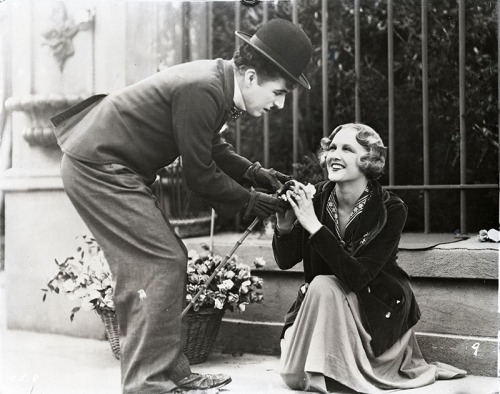
Charlie with co-star Virginia Cherrill

Chaplin knew his Little Tramp could never speak if he was to retain his universal appeal. But releasing a silent movie years after they had become obsolete was a huge gamble, and the press loved to speculate about it.
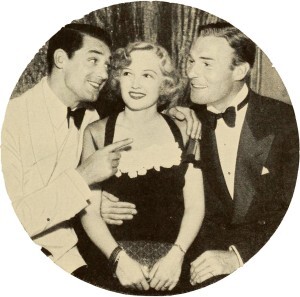 Along with a PDF tour of Los Angeles filming locations, this post covers some fun, random information about the movie many consider Charlie’s pinnacle achievement. (Check out the crossword puzzle below). Chaplin reportedly discovered co-star twenty year old Virginia Cherrill sitting ringside at a boxing match. She had never acted before. In 1934 Virginia would become Cary Grant’s first wife – the marriage lasted barely one year. Grant and his former roommate actor Randolph Scott, all pictured at left, resumed living together once the marriage ended.
Along with a PDF tour of Los Angeles filming locations, this post covers some fun, random information about the movie many consider Charlie’s pinnacle achievement. (Check out the crossword puzzle below). Chaplin reportedly discovered co-star twenty year old Virginia Cherrill sitting ringside at a boxing match. She had never acted before. In 1934 Virginia would become Cary Grant’s first wife – the marriage lasted barely one year. Grant and his former roommate actor Randolph Scott, all pictured at left, resumed living together once the marriage ended.


One fun discovery, not reported in my book Silent Traces, Charlie spots a discarded cigar butt while driving around his millionaire friend’s car, and leaps out to snag it just before another bum grabs it. This was filmed on South El Camino Drive, south from Wilshire Boulevard, with the newly opened Beverly Wilshire Hotel at back.



A testament to the skill of early filmmakers, before CGI effects, this remarkable production photo from the Chaplin Archive reveals the towering city skyline effect during the opening scene was created on Chaplin’s small studio backlot, placing a scale model in the foreground while filming the true two-story set in the far background, the so-called foreground (or hanging) miniature effect. What a stunning achievement – bravo.
 Among 28 pages of artwork and other publicity materials promoting City Lights, here’s a crossword puzzle (from page 6) with the answers further below in this post. With this PDF link you can print it out for home use. The first clue, one across, seven letters is “First name of greatest comedian in Motion Pictures.” Hmm, “Buster” and “Harold” are both six letters, who could it be?
Among 28 pages of artwork and other publicity materials promoting City Lights, here’s a crossword puzzle (from page 6) with the answers further below in this post. With this PDF link you can print it out for home use. The first clue, one across, seven letters is “First name of greatest comedian in Motion Pictures.” Hmm, “Buster” and “Harold” are both six letters, who could it be? 
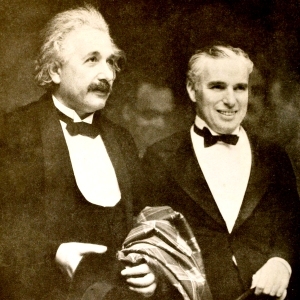
Albert Einstein and Chaplin at the premiere
In closing, I had the honor to introduce City Lights for the Los Angeles Conservancy a few years ago at their “Last Remaining Seats” screening held at the spectacular Los Angeles Theater, the very theater where the film premiered on January 30, 1931, with Albert Einstein and his wife Elsa in attendance as Charlie’s special guests. The entire house stood to honor them when they entered the theater. Chaplin was pleased to notice Einstein wiping his eyes during the emotional final scenes. It was the premiere screening ever held at the brand new theater. Incredibly, about 30 minutes into the show the theater owner interrupted the screening and turned up the house lights to brag about his new venue. Chaplin was understandably upset by the stunt.


Unlike the gritty locations appearing during The Kid (1921), Chaplin sought out modern and urbane settings for City Lights. Yet another example of how the varied streets of Los Angeles were employed to set just the right character and tone for the movies. This self-guided written tour prepared for LA Conservancy event (see link below) explains the many downtown and Wilshire Boulevard movie locations appearing during the film. Above, Charlie races to purchase Virginia’s flowers at the NW corner of Wilshire and S. Commonwealth Ave., with the corner of Lafayette Park behind them.
Charlie Chaplin City Lights Film Location Tour
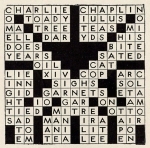 I didn’t forget – here are the crossword puzzle answers, also a PDF link if you want to print it out. Chaplin archival documents Copyright © Roy Export S.A.S or © Roy Export Company Establishment. All Rights Reserved CHARLIE CHAPLIN © Bubbles Incorporated S.A. All Rights Reserved. Read more posts about City Lights HERE. Hope to see you at the Paramount on February 19.
I didn’t forget – here are the crossword puzzle answers, also a PDF link if you want to print it out. Chaplin archival documents Copyright © Roy Export S.A.S or © Roy Export Company Establishment. All Rights Reserved CHARLIE CHAPLIN © Bubbles Incorporated S.A. All Rights Reserved. Read more posts about City Lights HERE. Hope to see you at the Paramount on February 19.


















